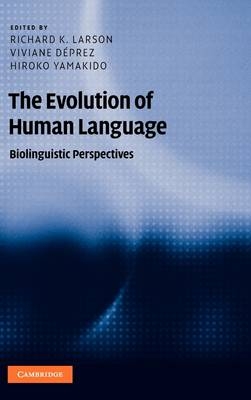
The Evolution of Human Language
Cambridge University Press (Verlag)
978-0-521-51645-7 (ISBN)
The way language as a human faculty has evolved is a question that preoccupies researchers from a wide spread of disciplines. In this book, a team of writers has been brought together to examine the evolution of language from a variety of such standpoints, including language's genetic basis, the anthropological context of its appearance, its formal structure, its relation to systems of cognition and thought, as well as its possible evolutionary antecedents. The book includes Hauser, Chomsky, and Fitch's seminal and provocative essay on the subject, 'The Faculty of Language,' and charts the progress of research in this active and highly controversial field since its publication in 2002. This timely volume will be welcomed by researchers and students in a number of disciplines, including linguistics, evolutionary biology, psychology, and cognitive science.
Richard K. Larson is Professor of Linguistics at Stony Brook University, New York. Viviane Depréz is Associate Professor of Linguistics at Rutgers University, New Jersey. Hiroko Yamakido is Assistant Professor of Japanese and Linguistics at Lawrence University, Wisconsin.
List of figures; Introduction; 1. The faculty of language: what is it, who has it, and how did it evolve? Marc Hauser, Noam Chomsky and W. Tecumseh Fitch; Part I. Language Architecture: 2. Some simple evo-devo theses: how true might they be for language? Noam Chomsky; 3. Your theory of the evolution of language depends on your theory of language Ray Jackendoff; 4. Three meanings of 'recursion': key distinctions for biolinguistics W. Tecumseh Fitch; 5. On obfuscation, obscurantism and opacity: evolving conceptions of the faculty of language Marc Hauser; Part II. Language and Interface Systems: 6. The evolution of anticipatory cognition as a precursor to symbolic communication Peter Gärdenfors and Mathias Osvath; 7. Did language evolve before speech? Michael Corballis; 8. A pragmatic perspective on the evolution of language Dan Sperber and Gloria Origgi; Part III. Biological and Neurological Foundations: 9. Canalization and plasticity in the evolution of linguistic communication: an evolutionary-developmental approach Daniel Dor and Eva Jablonka; 10. What is language, that it might have evolved, and what is evolution that is may apply to language? Massimo Piattelli-Palmarini; 11. The creative capacity of language, in what manner is it unique, and who had it? Philip Lieberman; 12. Genetics and the evolution of language: what genetic studies reveal about the evolution of language Karin Stromswold; Part IV. Anthropological Context: 13. A putative role for language in the origin of human consciousness Ian Tattersall; 14. On two incompatible theories of language evolution Derek Bickerton; 15. On the evolution of language: implications of a new and general theory of human evolution, properties and history Paul Bingham; Notes; Index.
| Erscheint lt. Verlag | 7.1.2010 |
|---|---|
| Reihe/Serie | Approaches to the Evolution of Language |
| Zusatzinfo | 6 Line drawings, unspecified |
| Verlagsort | Cambridge |
| Sprache | englisch |
| Maße | 152 x 229 mm |
| Gewicht | 580 g |
| Themenwelt | Geisteswissenschaften ► Sprach- / Literaturwissenschaft ► Sprachwissenschaft |
| Naturwissenschaften ► Biologie ► Evolution | |
| ISBN-10 | 0-521-51645-5 / 0521516455 |
| ISBN-13 | 978-0-521-51645-7 / 9780521516457 |
| Zustand | Neuware |
| Haben Sie eine Frage zum Produkt? |
aus dem Bereich


